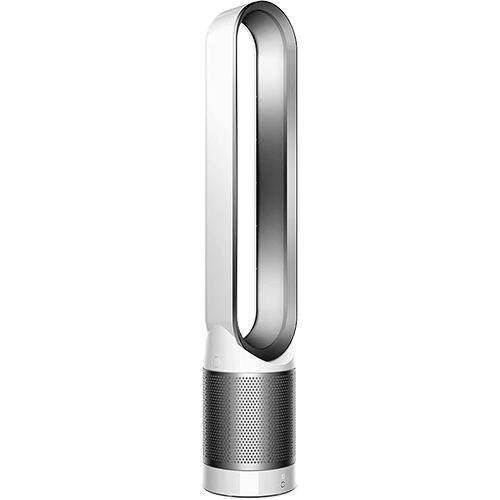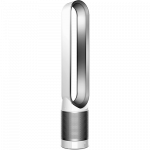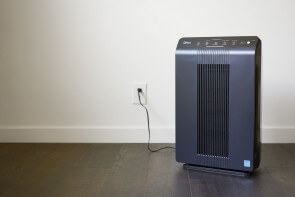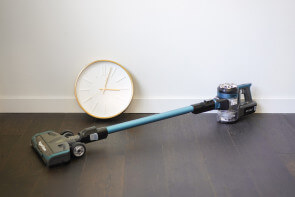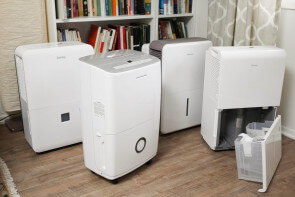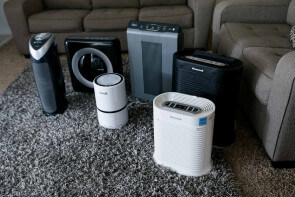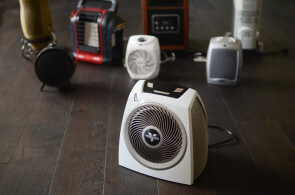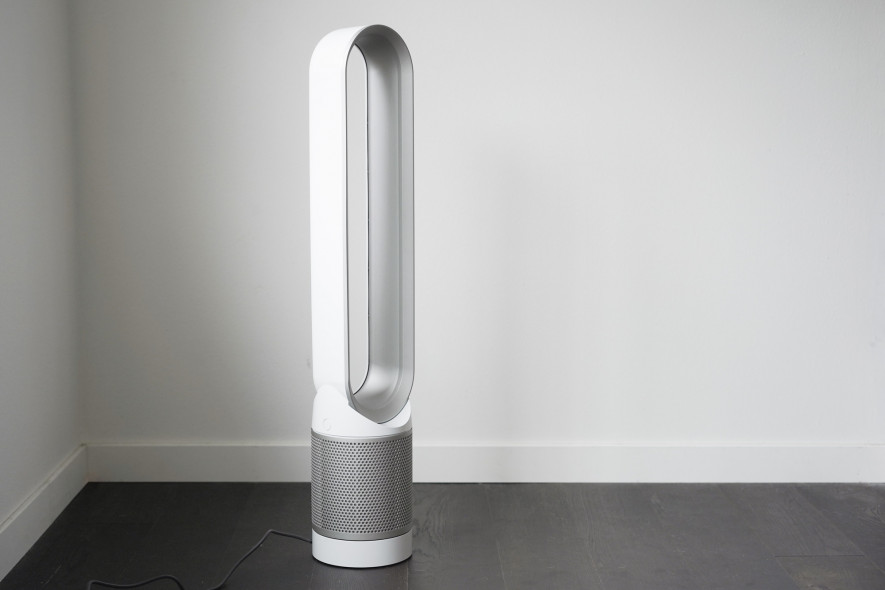
Dyson – TP01 Fan & Air Purifier Review
We previously reviewed an older, now-discontinued model, the Dyson – AM07, which we found to be effective but too expensive. Dyson has launched its latest line of fans, the TP series, which incorporates an air purifier, and though the Dyson – TP01 doesn’t have the smart features of the other TP series models, it’s still an impressive — and pricey — tower fan.
Featured Product
We previously reviewed an older, now-discontinued model, the Dyson – AM07, which we found to be effective but too expensive. Dyson has launched its latest line of fans, the TP series, which incorporates an air purifier, and though the Dyson – TP01 doesn’t have the smart features of the other TP series models, it’s still an impressive — and pricey — tower fan.
Table of contents
- Dyson technology
- New features
- Dyson – TP01 vs. Dyson – AM07
- Air purifier performance test
- The bottom line
Dyson technology

The Dyson company revolutionized vacuums with its cyclone technology and cordless designs, and we’ve reviewed and recommended several of them. Dyson also threw its team of engineers in designing a new type of fan, the so-called bladeless fans.
There’s no denying the amazing technology in a Dyson fan or more precisely — as we explain in our article about how bladeless fans work — an air multiplier. In brief, a Dyson’s motor is designed to force air upwards through the upper body’s loop. It then pulls in air surrounding the loop and multiplies the air volume before expelling it outward.
This explanation is still probably too technical, but put simply, the result is that the airflow is smoothed out. You feel a constant, gentle breeze, rather than the buffeting sensation you feel from a traditional bladed and oscillating fan.
The first Dyson fans were table fans, and instead of a loop, the upper body was a silver or black ring, something you might catch Sauron peering through. They were also notoriously noisy. The company spent three more years researching how to muffle the motor’s sound, and they succeeded in designing a much quieter model, which is now Dyson’s claim to fame. When we tested the Dyson – AM07 with other tower fans, it was quieter, but only by a few decibels, and the difference was not noticeable when compared with our top (and much cheaper) pick, the Seville Classics – UltraSlimline.
Dyson continues to refine their air multiplier’s technology, and Dyson has incorporated air purifiers, heating elements, humidifiers and air-pollution sensors into the newest models.
New features
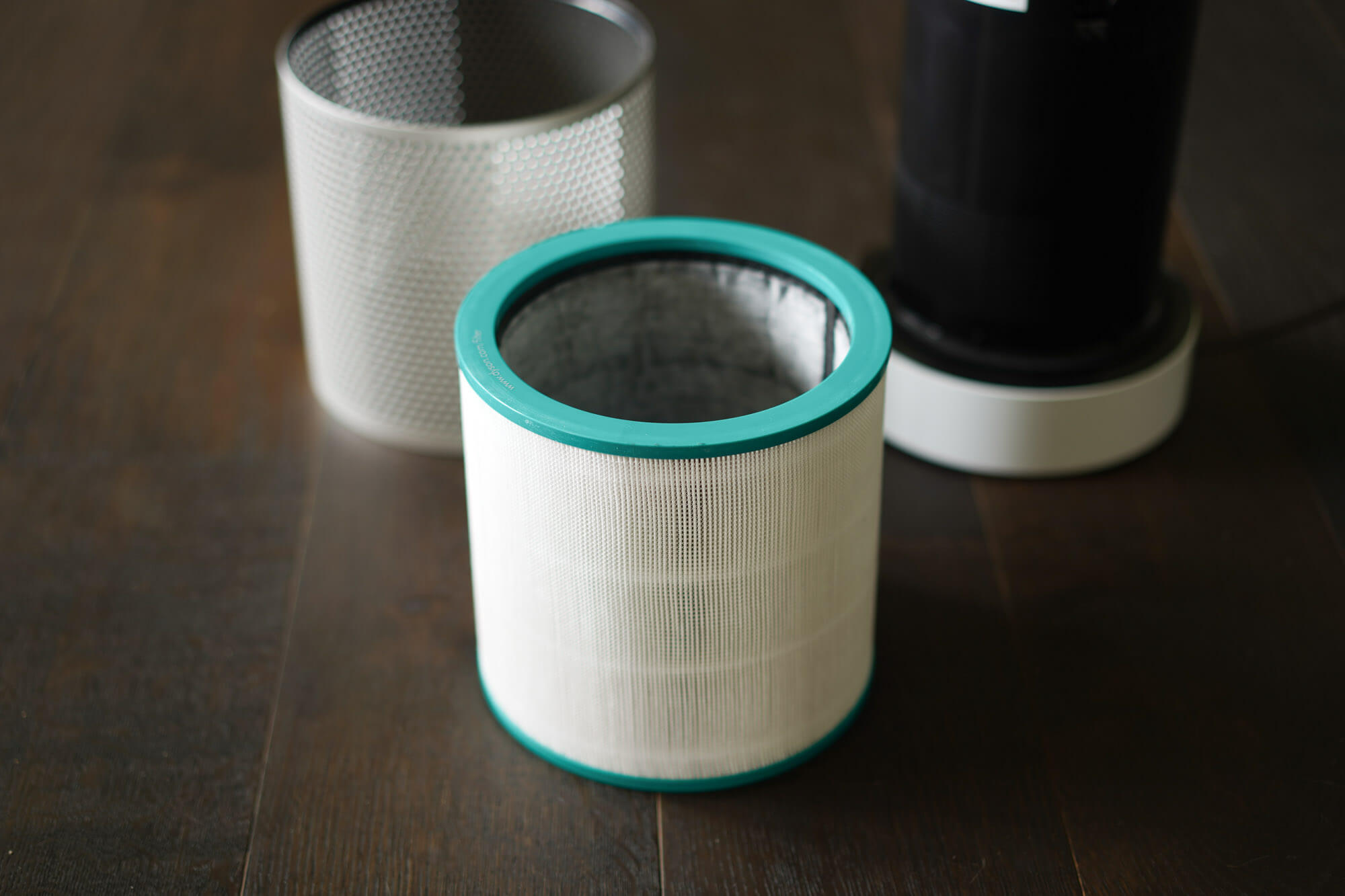
The TP series, also called Dyson Pure Cool, has a built-in air purifier with a high efficiency particulate-arresting (“HEPA”) filter, which Dyson claims only needs to be replaced once a year. The Pure Cool air multipliers pull in dust and allergens and expel clean air that is virtually free of pollutants (a 99.97% reduction of particles in air that passes through the filter).
The TP02 is Wi-Fi compatible and has an automatic mode for air purification, meaning it can turn the fan speed up when a sensor detects pollution in your air. The TP03 was an updated version of the TP02, but it’s no longer available.
The TP04 is the most significant change, adding an LCD display, thicker filters, and more pollution sensors to show you a more complete picture of your air quality. Its oscillation can be set up to 350 degrees to reach every corner of a room. You can also change the airflow direction, and a nighttime setting lowers airflow to a quieter level.
There’s no question that the TP series is remarkable, but is it worth almost $600 for the ability to see your air quality status in an app? You could buy a tower fan and an air purifier with a HEPA filter and perhaps get better results for less than half the cost.
As much as we love technological marvels, we found the newer models of the TP series too expensive and chose to test the TP01 — not exactly a bargain at $400 — to see how it compared to the discontinued AM07.
Dyson – TP01 vs. Dyson – AM07
| Product | Price | Air Flow Speed | Noise Level | Degrees of Oscillation | Power Usage (KwH) |
|---|---|---|---|---|---|
| Dyson - TP01 | $$$$ | 7.8 mph | 63 dB | 70 | .05 |
| Dyson - AM07 | $$$$ | 6.3 mph | 61 dB | 70 | .05 |
| Seville Classics - UltraSlimline | $ | 8.0 mph | 68 dB | 95 | .05 |
The Dyson – TP01 is very similar to the Dyson – AM07: It has 10 speeds that can be easily controlled manually by simply holding its power button, which increases the airflow incrementally. The TP01’s remote control does the same function, but you can also program the amount of time the fan will operate at a selected speed. To ensure the remote control won’t get lost or mixed up with other remotes, you can attach it magnetically to the top of the unit.
We tested the Dyson – TP01 for a full week, running it 24 hours a day in a bedroom that is approximately 155 square feet. We then tested it intermittently in an irregularly shaped living room/dining room that is approximately 400 square feet.
Levels 1 through 3 are intended for just removing low levels of dust in an empty room, since the airflow is minimal. However, in the bedroom, cooling at level 3 was quite effective. Overall the Dyson performed better in the smaller room. Despite Dyson’s marketing that the TP series can cool a large, airy room, we did not find that to be the case. Like other Dyson fans, it oscillates (only by using the remote control) at a limited 70-degree angle, which was fine for the bedroom. In the living room, however, even at its highest level, we felt almost no cooling from either side of the fan.
In our previous testing of tower fans, the AM07 had only modest airflow at 6.3 mph, while the inexpensive Seville clocked in at 8.0 mph. Dyson clearly made improvements on the TP01’s engineering, since its airflow was noticeably stronger at 7.8 mph. (We were curious about how the upper body’s engineering affected airflow, so we detached it and got a reading of a blustery 24.6 mph.)
As we noted in our review of the AM07, the Dyson’s selling point is its low noise level. The AM07 measured at 61 dB; the TP01 measured slightly higher at 63 dB. So Dyson improved the TP01’s airflow speed, but the noise level is about the same as its older model.
Air purifier performance testing
After receiving many requests from readers, we ran the TP01 tower fan through the same trials as other air purifiers we’ve tested.
Most air purifiers on the market today, even the poor-performance models we don’t recommend, use a similar HEPA-class filter that’s very good at capturing particles. The difference in performance mostly comes from how quickly the air in your room can be filtered — the thick filters slow down the air and require a strong fan. This crucial performance rating is usually certified by an independent agency in a Clean Air Delivery Rate (CADR) test.
The most frustrating thing about Dyson products is the deceptive tactics they use in their marketing. Dyson does some great engineering, but they hide most of the important performance numbers behind misdirection so that you can’t compare their products directly with the rest of the market. Dyson is betting that the high-performance features and unique look will make you love using their products, even if there are some low-performance trade-offs you don’t know about.
In this case, rather than submitting their tower fans for testing with the American Home Appliance Manufacturers’ Verifide program to get an apples-to-apples CADR rating for smoke, pollen and dust, Dyson came up with their own test, something they sometimes call the “POLAR” test. The most important thing about Dyson using their own test is that they don’t have to tell you the result, and you can’t look up a comparison with competing products.
They claim their test is better because of the size of their test chamber, the number of sensors they use, the number of pollutants they test for and the fact that they don’t have a circulating fan in their test chamber. But it doesn’t matter how many gaseous volatile organic compounds they test for, since they haven’t published the results or a performance comparison — not even between their own models.
In our tests, the Dyson’s maximum air velocity was at nearly the same as the best air purifier on its highest speed setting. That’s why it’s good for cooling. But the bigger-volume fan in the Winix moves 40% more air — 393 cubic feet per minute compared to Dyson’s 275. In testing, it took roughly four times longer to get the same improvement in air quality from a Dyson compared to a $130 Winix. The TP01 is also missing the air-quality sensor of its strongest competitors — you have to spend $100 more for the TP02 to get a sensor and Wi-Fi-based control.
At the lowest speed setting, the Dyson wasn’t even creating enough pressure to fill up the plastic bag we were using for air volume testing unless we took the filter off. There’s a gentle breeze because of the excellent air multiplier engineering, but it won’t make much difference for air quality unless you turn it up. For our low-speed test, we bumped the Dyson up to the fourth setting, which gave similar airspeed to the Winix set on its lowest setting.
In a small bedroom, the Dyson will be effective enough to manage dust, but that’s true of many air purifiers that cost less than a quarter its price.
The bottom line
We still can’t deny that the Dyson – TP01 is an amazing piece of engineering, particularly with the new addition of an air filter and the improvement in airspeed over the old model. Although this model doesn’t have an LCD read-out (as the TP04 has) to display what air pollutants have been removed, the air in the bedroom where we tested the TP01 did seem fresher.
We also found that the TP01 kept a smaller room cooler than it did in a large, open-air room, primarily because it does not have a side-to-side airflow. Likewise, while it would manage a certain level of dust in a quiet, well-kept apartment, there’s not enough airflow moving through the filter to make this an effective air purifier if people are stirring up dust every ten minutes.
As it was in our earlier review of an older model, the Dyson’s $400 price tag is its biggest drawback. However, with the inclusion of an air purifier with a HEPA filter that only needs to be changed once a year, you might be able to justify the cost. We still recommend, though, our top pick for tower fan, the Seville Classics – UltraSlimline and our top pick for air purifier, the Winix – 5300-2, as more affordable options.
More Reviews
Winix 5500-2 Air Purifier Review
Winix - 5500-2
Levoit LV-H132 Air Purifier Review
Levoit - LV-H132
Shark - Apex
Frigidaire - FFAD7033R1
Winix - 5300-2
Honeywell - HEV620
Amusing Ourselves to Death - Neil Postman, 1985
Vornado - Vortex AVH10
The Best Earplugs for Concerts
Vibes - Hi-Fidelity Earplugs


